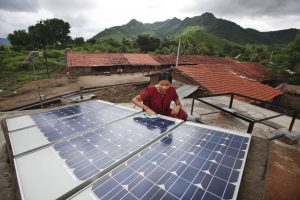China wants to leave Paris Climate Change Conference (COP21) with the image of a country that has an aggressively “green” stance on development, with strong climate targets and commitment to low-carbon growth. But time will tell whether or not this new position will also translate into reduced impacts on the ground both in China and in the country’s international ventures.
“We want to make progress in this area. We are trying to make a plan for after Paris to work at the heart of [international] cooperation and use this money to do good things on climate change in other countries,” said Gao Feng, a representative of the Chinese delegation at COP21.
Gao acknowledges that several China-led overseas projects, not least in Latin America, have left a trail of pollution, but emphasises that China has experience not just as the source of foreign investment in high-carbon industries, but also as a destination. Nevertheless, China will still endeavour to carry out new projects in the region which have fewer environmental impacts, Gao adds.
“They are in transition,” says Mónica Araya of sustainable development platform Nivela. “They have one foot in the future, with renewable energies, cleaner transport and South-South climate cooperation. But they also keep one foot in the past, with coal, and dirty energy-based infrastructure projects,” Araya says, adding that there is very little transparency around the impacts of such projects.
China-backed flagship projects such as the transcontinental railway still provoke controversy in Latin America. The railway, which is expected to pass through environmentally sensitive, forested areas inhabited by indigenous communities, is intended to facilitate China’s transport of raw materials.
And in Ecuador, Chinese investment in oil exploration in the Amazon rainforest jeopardises indigenous people and biodiverse national parks. China is now a major power in the market, buying hydroelectric plants in Brazil and building roads in Africa and Latin America, explains Paulo Adario of Greenpeace. “A country that takes on this weight of global responsibility must change its behaviour,” Adario adds.
Increasingly toxic levels of pollution caused by rapid industrialisation, are recognised by China, as is the need for urgent solutions. “Today China has the most ambitious reforestation program in the world,” claims Adario. “The country is not doing this because it cares about having a positive image. It has realised that it needs to make concrete promises to its population,” he adds.
Dialogue and transparency
In establishing strong environmental standards, China, with its enormous spending power and huge (if slowing) demand for natural resources, can send a positive message to the world through trade. As it develops, fulfilling its promise to reduce environmental impacts, both at home and abroad, will be closely observed.
In Brazil, for instance, one major concern is with the purchase of illegal forest products and commodities, such as soybeans. The Soybean Moratorium, an agreement in force since 2006 which binds signatory organisations to refrain from sourcing soybeans from areas not listed on Brazil’s rural environmental register, part of country’s Forest Code, correlated with lower levels of deforestation. But fears over Chinese companies buying regardless of origin remain.
“If China starts making large-scale direct purchases in Brazil, evidently the Soybean Moratorium may ‘go to pot’. The way in which China operates determines the game in several countries, this is the great risk,” says Adario, who coordinates the Moratorium group representing civil society.
Araya has closely followed China’s engagement with Costa Rica and has witnessed the operating model change over time. But Latin American governments also need increased dialogue with their Chinese partners.
“It’s an opportunity for Latin America. We have to show more ability to interact with China about renewable projects, collective transport and transparent projects,” Araya says.
Yet countries throughout the region are pursuing short term projects that do not necessarily include clean infrastructure. “It’s also necessary to maintain dialogue with shareholders, investors and not only with the Chinese government, so the Latin Americans do not run the even greater risk of being tied to projects that are not good for them, that are not in line with the new era,” adds Araya.
Paris might represent a ‘before’ and ‘after’ moment in the history of climate change negotiations, but one challenge will be to monitor what countries do in terms of bilateral cooperation on climate, and whether they will allow businesses to follow the earlier, environmentally high-impact route.




